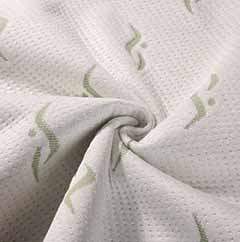In this article, we will examine nanotechnology, which is used in textile production as in every technological field and offered to people. But first of all, it would be more useful to go down to the etymological origin of this technology and give information about it. The meaning of the word nano is one billionth of a unit, which comes from the word Nanos. Nano is an invisible technology made with atoms, which are the building blocks of matter, and the textile industry has become an important application area in terms of nano technology. The use of nanotechnology in the textile industry today has revolutionized the field of textiles as well as in every other field. Nano, which is basically a unit of measurement, refers to technological studies developed in dimensions that cannot be seen with the naked eye.
After nanotechnology entered the field of textile, it is seen that many different studies have been carried out in this field. The products defined as nanomaterials and preferred in this field can be one, two and three dimensional. Generally one-dimensional ones can be used on extremely thin surface films and coatings. The biggest advantage of the use of nanotechnology in the textile industry has been the development of fabrics with antibacterial properties. Nanotechnology clothes developed by using this technology in the health sector have started to be used in daily life today. By producing such as PES, PES – Cotton and PES – Viscose, one side is called PES and the other side is cotton, providing both compatible fabrics that do not harm the human body and features that do not contain bacteria.
THE USE OF NANOTECHNOLOGY IN HOME TEXTILE IS EXPANDING
It is possible to talk about the new generation nanotechnology home textile product that protects the human body against external factors, as well as fabrics developed with nanotechnology that do not stain and do not contain bacteria. The most common use of nanotechnology in the field of textiles in the commercial sense is to add elements such as liquid repellency and stain and bacteria repellent properties to fabrics and clothes by using various nano particles.
Thanks to its hydrophobic surface production, it ensures that the water droplets of the clothes flow over the surface and do not take up place on the textile product. This type of products which have become widespread recently, has started to become common thanks to its self-cleaning ability. In these nanotechnology products preferred in clothing and home textiles:
Micro-capsules having stretch features, products that are resistant to UV rays and do not change color, micro-capsules that fight against bad odors, etc.
It is seen that nano materials with different properties are used. In addition to these, it is seen that nanotechnology applications are becoming widespread in many products in home textile and textile sector.
The era of smart clothing can begin
Thanks to nanotechnology, an era has begun in which clothes are getting smarter. There are many advantages of making a fabric or clothing smart. Especially in the defense industry, smart fabrics can make an instant report or determine the direction of the danger, for example, by transmitting the health status of a wounded soldier to the center. In the ready-to-wear and textile sector, the production of smart clothes using nanotechnology, the production of textile products connected to the Internet and their interaction, apart from their wrinkle, waterproof and antibacterial properties, paved the way for the development of such products in daily life. In the near future, the use of textile products developed with nanotechnology, which interact with the environment and offer solutions that protect the person against external factors and make life easier, will begin to become widespread.
The advantages of nanotechnology in smart fabrics and textiles, the use of nanotechnology in the apparel and textile sector provides many advantages. A number of basic features of fabrics in the known general sense are carried one step further thanks to this technology, enabling the development of products that will gain a much more widespread use in the future. Thanks to the use of nanotechnology fabrics in the clothing industry:
Self-cleaning fabrics, Anti-wrinkling, Antibacterial, can treat wounds and protect against external factors, control body functions, etc.
It is possible to talk about many different elements among the advantages of ready-made clothing products produced with fabrics with basic properties. On the other hand, experiencing color change with heat, light and different interactions or giving warnings by controlling the body functions of the person in terms of health, pulse, blood pressure, temperature, etc. has revealed that nanotechnology will also be determinant in the fashion of the future.
HOW ARE NANOTECHNOLOGY FABRICS MANUFACTURED?
Adding chemical substances to the fiber structure, by using different techniques in order to give various properties to textile products can be defined as the first stage of the development of nanotechnology products. It is also seen that methods such as adding the said chemicals to the synthetic fiber structure and adding them to the fabric surface during finishing processes are preferred. Coating the fabric surface with nanofiber polymer solution is also among the methods used in the development of nanotechnology textile products.
Home textile products caring skin
Nanotechnology is a product that is mostly used in the field of health today. The use of vitamin-based nano capsules, which is especially preferred in skin care, in clothes provides skin care. The support of the vitamins A, C and E in these capsules and their protection against toxins are among the factors that show the importance of the use of nanotechnology in the field of textiles.
Another method used in the production of nanotechnology fabrics is nanofiber coating. It is a method of improving the surface structure of the existing fabric by coating it with nanofibers to improve and develop its existing properties. It can be used to increase the usability of the fabric in different areas. Thanks to this method, the electrospin method generally enables the development of fabrics with antibacterial properties.
Brand new solutions making life easier
Nanotechnology textile products, developed by the joint use of microcapsules that produce fragrance (lavender, lily, etc.) and vitamin-based microcapsules, are among the technologies of the future that have the capacity to radically change our lives. Nanotechnology, which is used in many different fields, especially in textiles, is among the technologies that will carry humanity to the future, thanks to its brand new solutions that make life easier and because it is too small to be seen with the naked eye.
CURRENT USAGE AREAS OF NANOTECHNOLOGY TEXTILE PRODUCTS
Today, it is possible to see the usage areas of fabrics developed with nanotechnology in many different sectors. It can be used as protective clothing against UV rays or various chemical effects for people working in hazardous occupations, especially in the clothing of healthcare workers. In recent years, thanks to the use of nanotechnology and the development of application methods in this field, the use of nanotechnology on daily clothes is also seen. In addition to home textile products, it is also possible to talk about the use of masks with nanotechnology in the production of protective masks against viruses today.
Today, the main usage areas of textile products manufactured with nanotechnology are:
It can be listed as Marine clothing (swimsuits and beach towels), Home and vehicle textiles, Sports products, Construction and agriculture sector, Health and medical textile products, etc.
The most special products that will change the understanding of decorative and clothing that are suitable for use not only for professions but also for daily life have begun to be developed using nanotechnology.
Antibacterial fabric production is possible
Nanotechnology fabrics, which do not contain bacteria on the surface of the fabric and manage to fight bacteria on the surface on which they are coated, have an important place in the fight and protection of epidemic diseases that have increased recently. For example, carpets developed using nanotechnology in home textiles, ensure the rapid destruction of living bacteria, thanks to the coating of the surface layer with special nanomaterials. Similarly, antibacterial socks, which are also used in the defense industry and developed for special purposes, protect the feet of people against fungi or different types of bacteria and prevent bad odors.
The use of clothes and masks with antibacterial properties to protect the health of healthcare workers contributes to both the protection of body health and the prevention of the continued existence of viruses and bacteria on their clothes.
The usage area of antibacterial fabrics developed using nanotechnology has started to become widespread day by day.
 SleepTech Magazine Mattress, Accessories, Machinery, Raw Materials
SleepTech Magazine Mattress, Accessories, Machinery, Raw Materials



